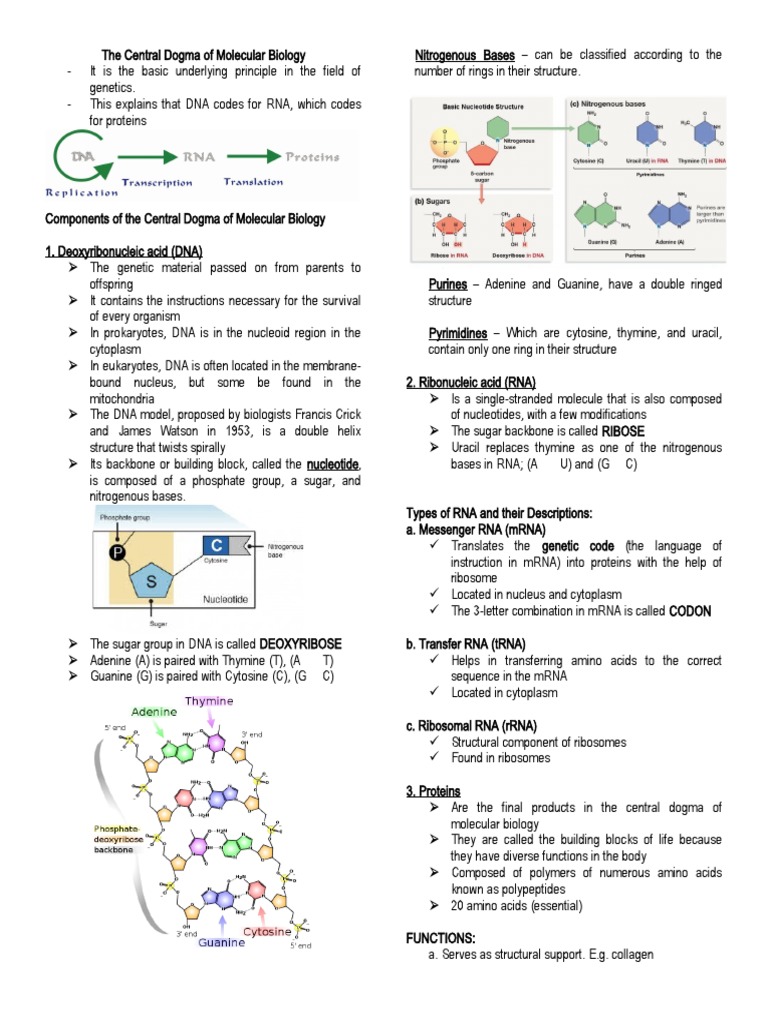The central dogma of molecular biology represents a foundational paradigm that delineates the flow of genetic information within a biological system. It can be envisioned as the intricate dance of information transfer, whereby the essence of life is orchestrated through a sequence of molecular choreography. The concept originated from the insights of Francis Crick in the 1950s, who proposed that genetic information flows from DNA to RNA and then to protein. This elegantly simple yet profound notion serves as the cornerstone for understanding various biological processes, from cellular metabolism to organismal development.
At its core, the central dogma elucidates three pivotal processes: replication, transcription, and translation. Each of these processes serves a distinct yet interlinked function, akin to the stages of a grand theatrical performance where each actor plays a vital role in the narrative arc of life.
Replication: The Duplication of the Genetic Script
Replication can be regarded as the initial act in this molecular theatre, wherein the double helix of deoxyribonucleic acid (DNA), the genetic script of life, is meticulously duplicated. This process is essential for cellular division, allowing each progeny cell to inherit an identical copy of the genetic material. The significance of replication cannot be overstated; it is foundational to the perpetuation of biological heritage.
The machinery of replication involves an array of enzymes and proteins. DNA polymerase, the principal actor in this drama, orchestrates the synthesis of new DNA strands using the original strand as a template. It is during this phase that the remarkable fidelity of genetic replication becomes crucial. Errors, while infrequent due to the proofreading capabilities of the DNA polymerase, can have monumental consequences—mutations that might lead to aberrant phenotypes or, in dire cases, pathologies such as cancer.
Transcription: The Conversion of DNA to RNA
Following replication, the next act unfolds—transcription. This process epitomizes the transformation of static information encoded in the DNA into a dynamic messenger known as ribonucleic acid (RNA). RNA plays a critical role in the cell, serving as the intermediary that conveys the genetic blueprint from the nucleus to the cytoplasm, where proteins are synthesized.
During transcription, a specific region of the DNA is unwound, allowing RNA polymerase to access the template strand. As strands of nucleotides are sequentially assembled into a strand of RNA, the paradigm of complementary base pairing emerges. Here, the thymine (T) within DNA is substituted by uracil (U) in RNA, a subtle but significant transformation that adds to the intricate complexity of molecular biology.
This process of transcription is tightly regulated, akin to a conductor leading an orchestra. The nuances of transcriptional regulation underscore the cell’s ability to adapt to its environmental conditions and meet its metabolic demands. Enhancers, silencers, and transcription factors, each play their part in modulating the transcriptional output, ensuring that not all genes are expressed uniformly, but in a spatially and temporally specific manner. Through this precise regulation, cells can differentiate and specialize, giving rise to the astonishing diversity of life.
Translation: The Synthesis of Proteins
Transitioning from transcription, translation represents a remarkable metamorphosis—the confluence of RNA and ribosomes into functional proteins, the workhorses of cellular biology. This intricate process can be likened to translating a novel into a film; the underlying narrative remains constant, yet the expression is entirely transformed. Here, the language of nucleotides is converted into the language of amino acids, the building blocks of proteins.
During translation, messenger RNA (mRNA) binds to the ribosome, a sophisticated molecular machine that facilitates the assembly of amino acids into polypeptide chains. Transfer RNA (tRNA) molecules serve as adaptors, bringing the appropriate amino acids corresponding to the codon sequence on the mRNA. The beauty of this process lies in its efficiency and specificity; each tRNA is charged with its respective amino acid, ensuring that the polypeptide chain is synthesized with precise fidelity.
The polypeptide chains then undergo folding and post-translational modifications, crucial steps that determine their functionality and fate within the cellular milieu. This post-translational processing may involve the addition of carbohydrate groups or phosphorylation, which can signify readiness for transport or activation. Ultimately, the final product—the functional protein—embodies the culmination of genetic expression.
The Interconnectedness of the Processes
The central dogma underscores the interconnectedness of replication, transcription, and translation. This trifecta embodies the essence of biological information flow, where the fidelity and regulation of each step bear profound implications for cellular function and organismal health. Disruptions in any of these processes can give rise to a myriad of diseases, illustrating the delicate balance maintenance necessary for life.
Beyond its mechanistic clarity, the central dogma serves as a metaphor for the broader principles of information transfer within any complex system—be it biological or otherwise. It speaks to the essential duality of stability and change, continuity and adaptation, reflecting life’s ongoing narrative where the past informs the present, and the present shapes the future.
In summary, the central dogma of molecular biology offers a captivating lens through which to view the processes governing life at the cellular level. By understanding the intricacies of replication, transcription, and translation, one acquires not only insight into the molecular underpinnings of biology but also a deeper appreciation for the elegant yet complex tapestry that is life itself. This synthesis of information stands as a testament to the unity of life’s mechanisms and the intricate web of relationships that define molecular biology.












